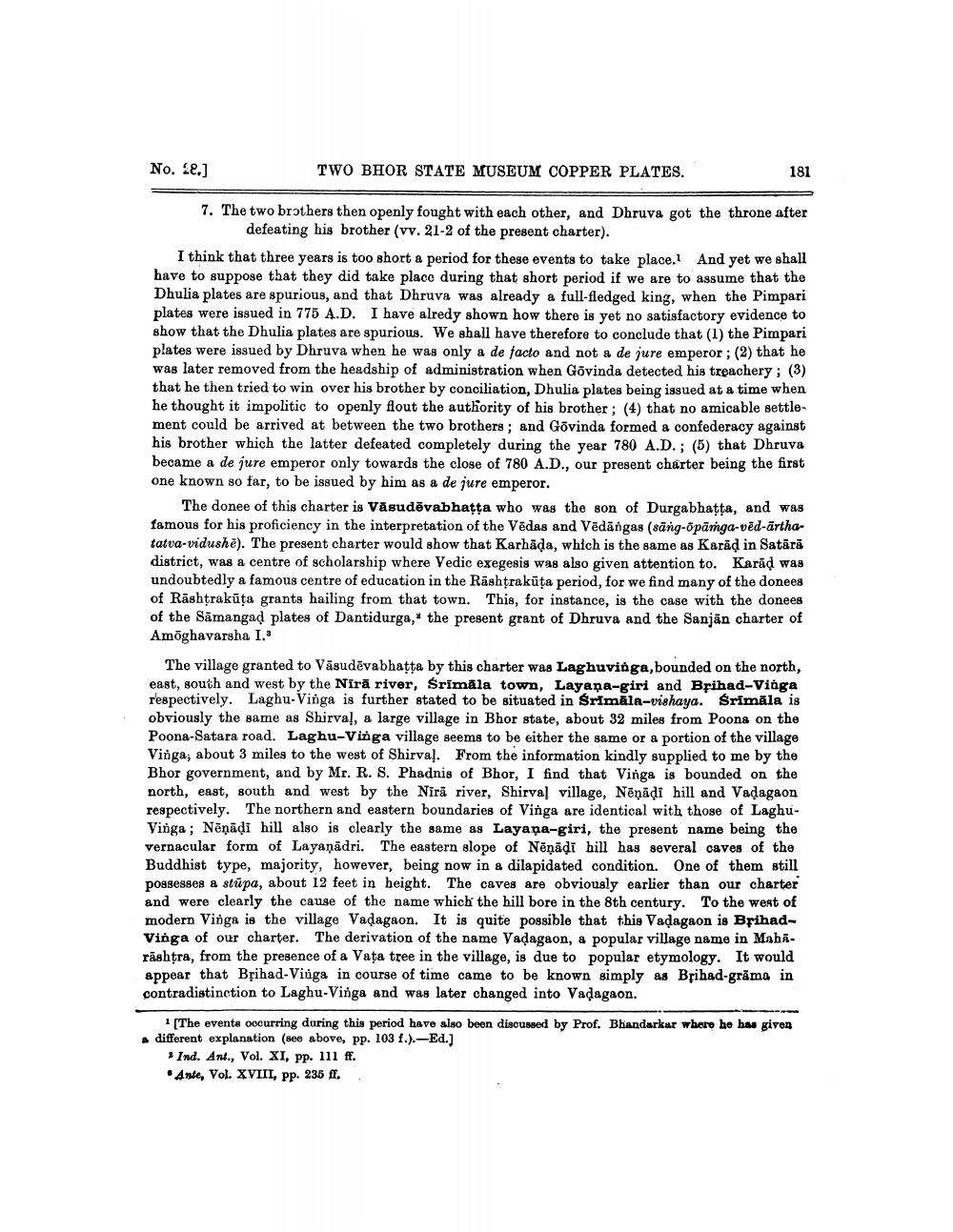________________
No. 28.]
TWO BHOR STATE MUSEUM COPPER PLATES.
181
7. The two brothers then openly fought with each other, and Dhruva got the throne after
defeating his brother (vv. 21-2 of the present charter). I think that three years is too short a period for these events to take place. And yet we shall have to suppose that they did take place during that short period if we are to assume that the Dhulia plates are spurious, and that Dhruva was already a full-fledged king, when the Pimpari plates were issued in 775 A.D. I have alredy shown how there is yet no satisfactory evidence to show that the Dhulia plates are spurious. We shall have therefore to conclude that (1) the Pimpari plates were issued by Dhruva when he was only a de facto and not a de jure emperor; (2) that he was later removed from the headship of administration when Govinda detected his treachery ; (3) that he then tried to win over his brother by conciliation, Dhulia plates being issued at a time when he thought it impolitic to openly flout the authority of his brother; (4) that no amicable settlement could be arrived at between the two brothers; and Govinda formed a confederacy against his brother which the latter defeated completely during the year 780 A.D.; (5) that Dhruva became a de jure emperor only towards the close of 780 A.D., our present charter being the first one known so far, to be issued by him as a de jure emperor.
The donee of this charter is Vāsudēvabhatta who was the son of Durgabhatta, and was famous for his proficiency in the interpretation of the Vēdas and Vidängas (särg-opāṁga-vēd-ārthatatva-vidushë). The present charter would show that Karhäda, which is the same as Karād in Satārā district, was a centre of scholarship where Vedic exegesis was also given attention to. Karād was undoubtedly a famous centre of education in the Rāshţrakūta period, for we find many of the donees of Rashtrakūta grants hailing from that town. This, for instance, is the case with the donees of the Samangad plates of Dantidurga," the present grant of Dhruva and the Sanjän charter of Amõghavarsha I.
The village granted to Väsudēvabhatta by this charter was Laghuvinga, bounded on the north, east, south and west by the Nirā river, Brimāla town, Layana-giri and Brihad-Vinga respectively. Laghu-Vinga is further stated to be situated in Srimāla-vishaya. Srimāla is obviously the same as Shirval, a large village in Bhor state, about 32 miles from Poona on the Poona-Satara road. Laghu-Vinga village seems to be either the same or a portion of the village Vinga; about 3 miles to the west of Shirva!. From the information kindly supplied to me by the Bhor government, and by Mr. R. S. Phadnis of Bhor, I find that Virga is bounded on the north, east, south and west by the Nīrā river, Shirval village, Nēņādi hill and Vadagaon respectively. The northern and eastern boundaries of Vinga are identical with those of LaghuVinga; Nēņādi hill also is clearly the same as Layaņa-giri, the present name being the vernacular form of Layanādri. The eastern slope of Nēņādi bill has several caves of the Buddhist type, majority, however, being now in a dilapidated condition. One of them still possesses a stūpa, about 12 feet in height. The caves are obviously earlier than our charter and were clearly the cause of the name which the bill bore in the 8th century. To the west of modern Vinga is the village Vadagaon. It is quite possible that this Vadagaon is BrihadVinga of our charter. The derivation of the name Vadagaon, a popular village name in Maharashtra, from the presence of a Vața tree in the village, is due to popular etymology. It would appear that Bțihad-Viuga in course of time came to be known simply as Brihad-grāma in contradistinction to Laghu-Vinga and was later changed into Vadagaon.
1 [The events occurring during this period have also been discussed by Prof. Bhandarkar where he has given different explanation (see above, pp. 103 f.). -Ed.)
Ind. Ant., Vol. XI, pp. 111 ff. . Ante, Vol. XVIII, pp. 236 ff.




